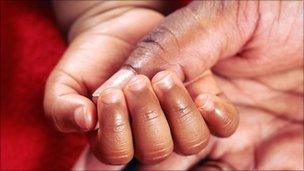The size of the average family is getting smaller
- Published

Families are getting smaller
The size of the average family seems to be getting smaller, according to the Office for National Statistics (ONS).
Researchers looked at women born in England and Wales in 1964 and compared them with their mother's generation, represented by women born in 1937.
By 2009, they had on average 1.9 children, while at a similar stage in their lives their mothers had on average 2.4 children.
Levels of childlessness are also higher for the younger generation.
Twenty per cent of women born in 1964 are childless, compared to 12% of women born in 1937.
That is a 44-year-high, comparable to women born in 1920 whose early 20s - when they would have been most likely to start a family - coincided with WWII.
Generations
The 1964 generation was chosen because it is assumed that group of women has now finished having babies.
The older generation were chosen because, in 1964, the average age of giving birth was 27, and women of that age were born in 1937.
The most common family size for both groups is two children, but larger families are becoming rarer.
Only one in 10 women from 1964 had a family of four or more, compared to twice that number for their mothers' generation.
Falling birth rate
The commonly-used figure of "2.4 children" only really represents the families' of women born in the mid-1930s to early '40s.
Women born in the 1960s and '70s have also tended to have had fewer children at age 30 than previous generations.
Figures published by the ONS earlier this year showed a fall in the annual birth rate in England and Wales for the first time in eight years.
The Total Fertility Rate (TFR) for 2009 shows an average of 1.96 children per woman in England and Wales, although this figure is still relatively high, given that the 2008 figure was at its highest rate for 35 years.
Wendy Sigle-Rushton, a senior lecturer in Social Policy at the London School of Economics, says fertility in England and Wales has remained high and stable compared to much of Europe - despite social and demographic changes.
"In contrast to most other countries with relatively high levels of fertility - for example France and the Nordic countries - the government has been reluctant to implement policies to encourage childbearing.
"Many of its policies aimed at supporting families with children reinforce a traditional division of labour, so the Fatherhood Institute recently ranked the UK 18 out of 21 OECD countries in its support for shared working and caring within families.
"Women may find it difficult to combine full-time, well-paid work and childbearing.
"Put simply, fertility appears to have remained stable despite, rather than because of, government actions of the kind we see in other countries with similar fertility levels."
- Published25 October 2010
- Published14 September 2010